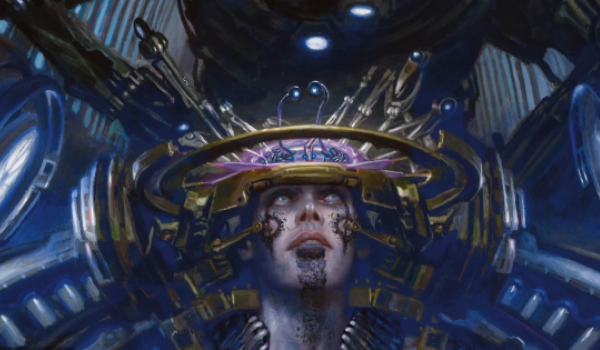Are you a Quiet Speculation member?
If not, now is a perfect time to join up! Our powerful tools, breaking-news analysis, and exclusive Discord channel will make sure you stay up to date and ahead of the curve.
Draft is self-correcting.
Or so they say.
The age-old expression implies that if a given color or given strategy is over-powered in a given format, then it will be over-drafted. Which will cause the weaker colors to be more available. An equilibrium then takes place, allowing the weaker color to rise up and perform nearly as well as the stronger colors.
While we are starting to see changes in ONE, blue is still the least desirable color. Pick orders are shifting to reflect this. We are prioritizing red and white and to a lesser extent green. This inbreeding of the format weakens the best decks, and in theory should strengthen blue considerably. Still, I'm not sure it's advisable to actively be looking to move into blue.
The Problems with Blue
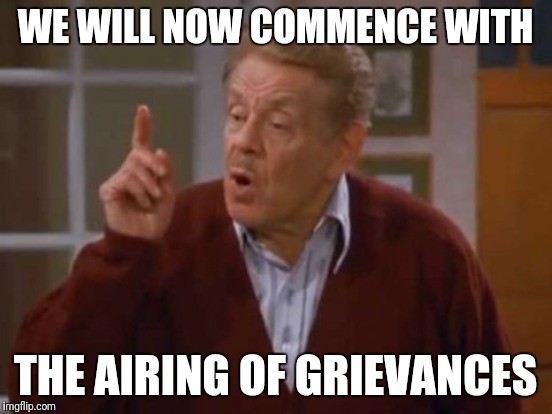
Even in our preview guide, we recognized the overall low power level of the blue cards. However, the rules of engagement in the format amplify those problems. Blue has the worst removal, by far, of all the colors. It also has bad early plays and struggles to assert control over the tempo of a game. Even if our blue deck does stabilize, the payoffs make it hard to win before our opponent is able to break through our defenses with a Hazardous Blast, Flensing Raptor, haste creatures, lethal proliferate effects, or by eking out combat damage with For Mirrodin! equipment. Additionally, the speed of the format punishes counterspells and cantrips, which should be an area where blue gains its edge.
Even worse, Experimental Augury has been a flop. It doesn't impact the board, which complicates its inclusion in many decks, and this card seems like it should be the glue piece in blue.
In theory, we want the proliferate effect, the card selection, and the noncreature spell. However, the speed of the format puts constraints on this card. Meldweb Strider is often priced into using its lone counter and Ichor Synthesizer eats a lot of combat tricks because blue lacks the cheap interaction to fight back. Blue falls behind a lot, and it struggles to turn the corner. Whether it's losing early or losing late, blue tends to be losing.
Concerns with Blue-Based Artifact Decks
Chrome Prowler has been the best blue common in my experience, but the rest of the artifact deck is inconsistent by design. Eye of Malcator and Escaped Experiment are embarrassing on defense, yet these are the tools that we are expected to build around.

A three-mana 4/4 that scrys when it enters the battlefield should be great in this format. However, the fact that we have to use our mana before sending it into combat is a major knock against it. Additionally, there are going to be a lot of times when we can't activate it, and this format punishes such fumbles. Worst of all is when we try to use it on defense. Again, Chrome Prowler is a reasonable way to make this happen, but don't try and sell me on Charge of the Mites here. If we have to make two 1/1s that can't block to help us play defense, we're in a lot of trouble.
This card is strong when we're beating down, but missing an attack can be a major drawback. While there are decks for Eye of Malcator, it is not a card that we should prioritize in the draft, due to its inconsistency. Furthermore, these cards get paired with uncommon support like Transplant Theorist and Tamiyo's Logbook which are designed to play a longer, grindier game.
Blue Tools
The best performing blue commons are the three-drops: Gitaxian Raptor and Chrome Prowler. These cards are an exception in blue, as they play well on offense and defense. In a lot of formats, I would be happy with Malcator's Watcher, but cycling our two-drop on the battlefield for a card in hand is not something I'm excited about here.
Those are really the only commons in blue we should be excited about, though Experimental Augury still has upside as long as we can support it in a reasonable shell. Typically, I'm only looking to play this in a deck with multiple copies of Scheming Aspirant or Axiom Engraver.
Getting Punished for Doing the Right Thing
When we see a late Chrome Prowler, we should take it as a sign. As blue cards keep tabling, we might take it as a certainty that blue is open. When we see our pick fourteen Malcator's Watcher, our dream of being the only drafter in a specific color may be all but realized. We're alone in blue! Typically, any time we're the only drafter in a color, it's going to work out well for us. However, in ONE, it might not.
Even if blue is wide open, we are still at the mercy of the packs. Blue's best uncommon is Unctus's Retrofitter, which is indeed very good. Additionally, I have found Tamiyo's Immobilizer to have outperformed its 54.5% GIH WR. But beyond those two, there is a steep drop-off at uncommon.
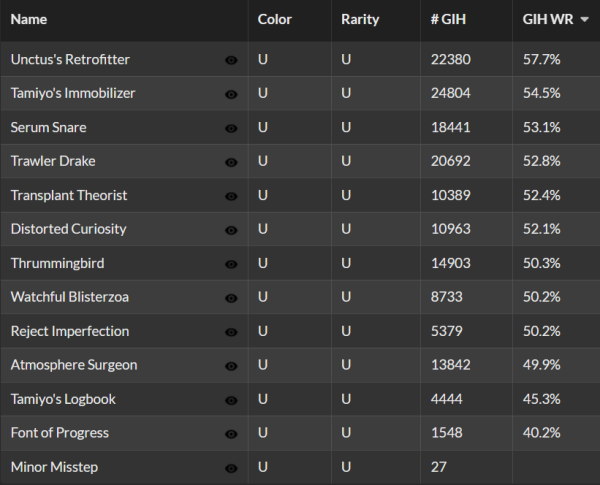
Serum Snare is a nice tool, in that it gives blue cheap interaction. For this reason, I also really like to include a single Aspirant's Ascent in my blue decks. Both of these cards help shore up a weakness, but neither is particularly strong. If we don't include them, we're basically hoping to dodge Blazing Crescendo and every fight spell in the format. Not great.
Speculate Until You Know It's Safe
When we see an opportunity to snag a blue card because it is the best card in a pack, we should do so. However, blue should almost never be our main color. This is, to a lesser extent, true about black as well.
Perhaps we took an early white card, got deep into red, and then see a Chrome Prowler or Serum-Core Chimera. We can take that card and continue drafting the good red cards that we see. If good green cards come, then we can easily switch. If we keep seeing good blue cards, then perhaps UR is a reasonable landing spot for our deck.
The draft below started off with the top two blue uncommons. For the sake of truthfulness, I have been leaning into blue in an effort to broaden my understanding of the format (this has not been great for my rank). The Atraxa's Skitterfang was probably the best choice pack one, pick one. I stand by the other picks.
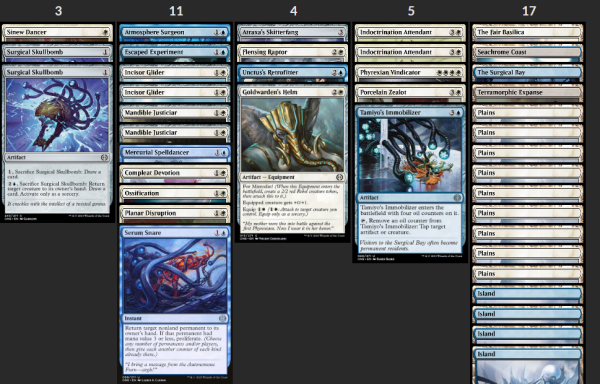
UW 3-0
Blue Is a Support Color
We simply do not want a lot of blue cards in our decks. We want to make sure that we can get deep into another color, and then take advantage of the stronger blue cards that we see, because no one else is prioritizing them.
As a result, the best colors to pair with blue are red and white because those have the best assortment of commons.
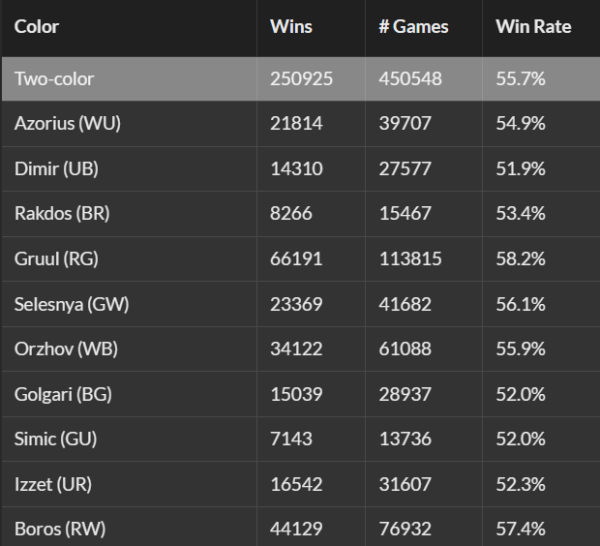
UW unsurprisingly has the highest win rate amongst the blue decks. The artifact theme lives in that color pair, and white provides Mandible Justiciar, a premium role-player in that deck. The lifegain offsets the struggles we discussed earlier regarding Eye of Malcator. Additionally, white toxic decks can get some value from blue's proliferate effects, and some of the cards that can help it gain tempo.
Toxic tempo
Big Red, Little Blue
UR has been better for me than this chart would imply. The Jeskai wedge offers artifact synergies, but we should be more interested in card quality. This deck found a strong cache in red, and speculated on blue early. That speculation panned out nicely.
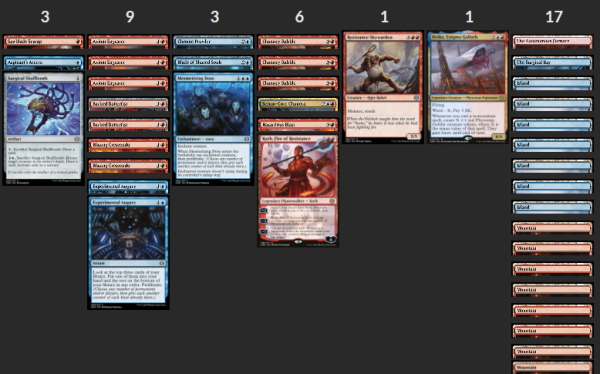
UR 7-2
This deck gets a lot of value out of Axiom Engraver to play a longer game, but as we can see, it's mostly a red deck. Because red and white offer so many more playables than the other colors, we shouldn't be stunned that those decks outperform the other color combinations. The biggest mistake players are making in UR is committing to the spell-based synergies, as that is putting them behind on board.
Red wants to be assertive and aggressive, but its best attribute is high card quality. One nice, minor synergy is that Barbed Batterfist counts as a noncreature spell while offsetting blue's lack of assertive early plays. A red base makes sense as a shell for good blue cards, because red shines where blue falters, namely with cheap interaction and strong early plays.
Finally, if red has any weakness, it's the three-drops, and blue's best commons are its threes. This archetype should be more about good cards than the spells-matters synergies, which means that it should be more red than blue.
The Threshold for Getting Into UB or UG
I've had success in UB, but those decks were able to avoid playing many commons. In general, I think both UB and UG are traps. Neither of these colors support blue's weaknesses enough. The same truism nonetheless applies here as above. If we can get very deep into one of these colors and are seeing a ton of strong cards, we can still take the good blue picks if no one else wants them.
I imagine Whisper of the Dross and maybe Offer Immortality could play okay with Ichor Synthesizer, but those are all cards I'm hoping to avoid playing in general.
The rule with blue is that we want both blue and the other color to be very open. In these combinations, my threshold for "very open" is much higher. These colors aren't nearly as deep as red or white, and blue is critically shallow. Honestly, I'm surprised the win percentage for these colors isn't higher, because the only reason I would end up in these pairs is if I was seeing insane card quality. While blue is not as unplayable as some have made it out to be, it really does need a strong partner. It's hard to make that combination with black and green.
Blue or Not
There is an opportunity, right now, to get in on blue. We just want to exercise caution in doing so. In a lot of pods, blue is wide open, and that might be a good thing. But if we commit to blue early and its strong cards aren't opened at the table, it won't matter how open the color is. The synergies are a nice bonus, but we need to prioritize high card quality.
Remember, we can speculate on this color without committing to it. That's the best way to navigate a draft in general, but with blue in ONE, the door must be left ajar. I'm not committing to blue until I see, at the least, two very good cards.
We can take a Retrofitter early, but we should lean towards our other color to build depth. While we took an early blue card, we're not married to it. Never go blue for the commons; speculate on blue if it seems open, but don't commit until you have strong reason to stay in the color. If we follow those rules, we can pick up a lot of equity in playing the format's most under-drafted color.


